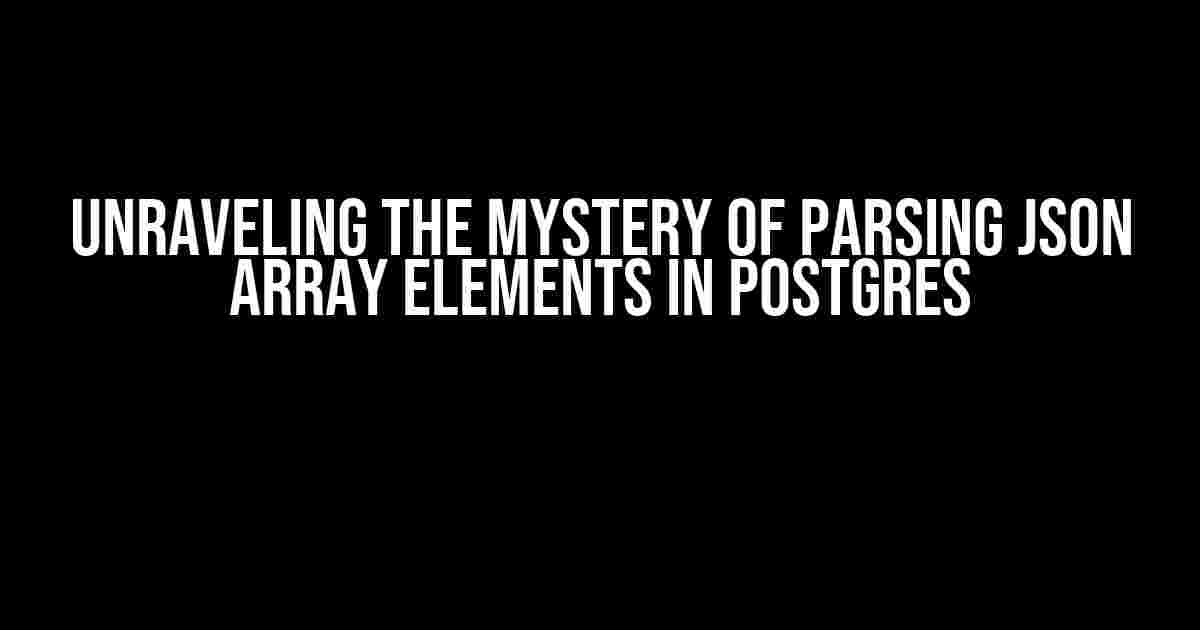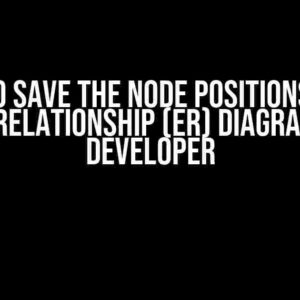Hey there, fellow database enthusiasts! Are you tired of wrestling with JSON arrays in Postgres, wondering how to extract those pesky elements and make sense of them? Fear not, dear reader, for we’re about to embark on a thrilling adventure to demystify the art of parsing JSON array elements in Postgres. Buckle up, and let’s dive in!
The Basics: What is JSON and Why Do We Need to Parse It?
JSON (JavaScript Object Notation) is a lightweight data interchange format that’s become the de facto standard for exchanging data between web servers, web applications, and mobile apps. It’s concise, easy to read, and simple to generate. However, when it comes to storing and querying JSON data in Postgres, things can get a bit hairy.
Postgres, being the awesome database management system it is, supports JSON data types, including `json` and `jsonb`. The `json` data type stores JSON data as a string, while `jsonb` stores it in a binary format that allows for more efficient querying and indexing.
But, when we store JSON arrays in Postgres, we need a way to extract and manipulate those individual elements. That’s where parsing comes in – the process of breaking down the JSON array into its constituent parts, making it possible to query, filter, and transform the data to our heart’s content.
Method 1: Using the `json_array_elements` Function
One of the most straightforward ways to parse JSON array elements in Postgres is using the `json_array_elements` function. This function takes a JSON array as input and returns a set of rows, each containing a single element of the array.
SELECT * FROM json_array_elements '[1, 2, 3, 4, 5]' AS elements(value);
This will produce the following result:
| value |
|---|
| 1 |
| 2 |
| 3 |
| 4 |
| 5 |
As you can see, the `json_array_elements` function has broken down the JSON array into individual rows, making it easy to work with each element separately.
Method 2: Using the `jsonb_array_elements` Function
If you’re working with `jsonb` data type, you can use the `jsonb_array_elements` function instead. This function works similarly to `json_array_elements`, but returns a `jsonb` value for each element in the array.
SELECT * FROM jsonb_array_elements '[1, 2, 3, 4, 5]'::jsonb AS elements(value);
The result will be identical to the previous example, but with `jsonb` values instead.
Method 3: Using JSON Path Queries
Postgres 12 and later versions introduce JSON Path queries, which provide a more powerful and flexible way to parse JSON array elements. You can use the `jsonb_path_query` function to extract specific elements from a JSON array.
SELECT * FROM jsonb_path_query '[1, 2, 3, 4, 5]'::jsonb, '$. [*]' AS elements(value);
In this example, the `$. [*]` path expression tells Postgres to extract all elements from the JSON array. The `*` is a wildcard that matches all elements.
JSON Path queries also allow you to use more complex path expressions to extract specific elements based on conditions or filters.
SELECT *
FROM jsonb_path_query '[{"id": 1, "name": "John"}, {"id": 2, "name": "Jane"}]'::jsonb, '$. [*]?(@.id == 1)' AS elements(value);
This query extracts the JSON object with `id` equal to 1 from the array.
Method 4: Using Lateral Join
Another approach to parsing JSON array elements is by using a lateral join with the `unnest` function. This method is particularly useful when you need to join the JSON array elements with other tables or perform more complex queries.
SELECT * FROM mytable, LATERAL unnest(mytable.json_array) AS elements(value);
In this example, `mytable` is the table containing the JSON array column, and `unnest` is used to break down the array into individual elements. The `LATERAL` keyword allows the subquery to reference columns from the main table.
Real-World Scenarios: When to Use Each Method
Now that we’ve covered the different methods for parsing JSON array elements in Postgres, let’s explore some real-world scenarios where each method might be more suitable:
-
Method 1: `json_array_elements` is ideal for simple cases where you need to extract all elements from a JSON array and perform basic queries.
-
Method 2: `jsonb_array_elements` is preferred when working with `jsonb` data type and you need to return `jsonb` values for each element.
-
Method 3: JSON Path queries are perfect for more complex scenarios where you need to extract specific elements based on conditions or filters, or when you need to navigate nested JSON structures.
-
Method 4: Lateral join with `unnest` is suitable when you need to join the JSON array elements with other tables or perform more complex queries that require referencing columns from the main table.
Conclusion
In conclusion, parsing JSON array elements in Postgres is a breeze with the right tools and techniques. Whether you’re working with `json` or `jsonb` data types, Postgres provides a range of functions and methods to help you extract and manipulate individual elements.
By mastering these methods, you’ll be able to unlock the full potential of JSON data in Postgres, and unlock new possibilities for your applications and analytics.
So, the next time you’re faced with a JSON array in Postgres, remember: you’ve got this! Just choose the right method, and you’ll be parsing like a pro in no time.
Further Reading
For more information on working with JSON data in Postgres, check out the following resources:
-
Postgres documentation: JSON Data Type
-
Postgres documentation: JSON Functions and Operators
-
Postgres wiki: JSON Basics
Happy parsing, and see you in the next adventure!
Frequently Asked Question
Get ready to dive into the world of Postgres and JSON arrays!
How do I parse a JSON array in Postgres?
You can use the `json_array_elements()` function in Postgres to parse a JSON array. This function takes a JSON array as an argument and returns a set of JSON values, one for each element in the array.
What if I want to parse a JSON array with a specific column in Postgres?
You can use the `json_array_elements()` function in combination with the `->>` operator to parse a specific column from a JSON array. For example, `SELECT * FROM json_array_elements(my_column->’my_array’)` would parse the `my_array` column from the `my_column` JSON object.
How do I iterate over a JSON array in Postgres?
You can use a `LATERAL` join to iterate over a JSON array in Postgres. For example, `SELECT * FROM my_table, LATERAL json_array_elements(my_column->’my_array’)` would allow you to iterate over the `my_array` column and access each element individually.
Can I use JSON array parsing with other Postgres data types?
Yes, you can use JSON array parsing with other Postgres data types, such as integers or text. For example, you can use `json_array_elements_text()` to parse a JSON array of text values, or `json_array_elements_int()` to parse a JSON array of integers.
Are there any performance considerations when parsing JSON arrays in Postgres?
Yes, parsing large JSON arrays in Postgres can be performance-intensive. To improve performance, consider using an index on the JSON column, and use efficient parsing methods such as `json_array_elements()` instead of using functions like `json_each()`.



